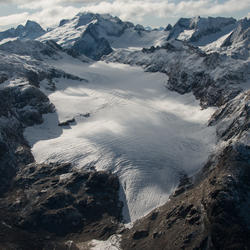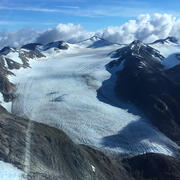Mountain glaciers are dynamic reservoirs of frozen water, deeply interconnected with their surrounding ecosystems. Glacier change in North America has major societal impacts, including to water resources, natural hazard risk, tourism disruption, fisheries, and global sea level change. Understanding and quantifying precise connections between changing glaciers, the surrounding landscape and climate is critical to decision makers, land managers, and the public, who are affected by these consequences of glacier change. The USGS Benchmark Glacier Project is aimed at solving complex scientific problems in snow and ice across North America to promote enhanced monitoring, analysis, and prediction of mountain glacier change. Utilizing expertise across USGS, this project combines legacy glacier monitoring with remote sensing and contemporary analytical methods to create novel insight and deliver relevant, actionable science.
USGS Benchmark Glacier Project

The flagship research effort of the Glaciers and Climate Project is a multi-glacier, decades-long study of glacier-climate response. Since the 1950s, glacier mass-balance measurements have been systematically collected at five benchmark glaciers, beginning with South Cascade (WA) and later including Gulkana, Wolverine and Lemon Creek Glaciers (AK). Sperry Glacier (MT), monitored since 2005, was added to complete the geographically diverse network in 2013.
Results from this monitoring form the longest continuous record of North American glacier mass balance, which capture seasonal and year-to-year variability. These intensively studied glaciers provide insight into the connection between climate and glaciers at multiple scales.
Historic glacier monitoring has involved various mission areas across USGS, but research was unified into one cohesive program in 2019 (O'Neel and others, 2019). Common field methodologies coupled with long-term, consistently analyzed records, are the hallmark of the Benchmark Glacier Project. Such consistency among sites allows glacier records from different climate zones of North America to be directly compared in order to better understand the impacts of mountain glacier change response of glaciers. Four of the glaciers are considered ‘reference’ glaciers in the World Glacier Monitoring Service’s internationally coordinated glacier monitoring network.
The USGS Benchmark Glacier Project also incorporates data collected from spaceborne and airborne platforms, enabling scientists to document three-dimensional glacier change at regional scales. This application of remotely sensed data broadens the project’s scope and relevance to facilitate glacier change projections, which guide sea level and water resource management strategies.
Benchmark Glaciers
Location of five benchmark glaciers
Gulkana
Lemon Creek
South Cascade
Sperry
Wolverine

Glacier Mass Balance
Research on Other Glaciers
Additional Resources
South Cascade Glacier
Gulkana Glacier
Lemon Creek Glacier
Additional Research Glaciers
Wolverine Glacier
Sperry Glacier
Mass Balance Summary
Mass Balance Methods - Measuring Glacier Change
Analyzing North American Glacier Change
Biogeochemistry of glaciers
Time Series of Glacier Retreat
Status of Glaciers in Glacier National Park
Glacier-Wide Mass Balance and Input Data
This data release includes compiled inputs to calculate glacier-wide mass balances, including point mass balances, time-variable area-altitude distributions, geodetic mass changes, and daily values of temperature and precipitation from proximal weather stations. If the input data is complete, there are also files with calculated glacier-wide mass balances.
Annual End-of-Summer Snow Cover on Glaciers in Alaska and Northwest Canada Annual End-of-Summer Snow Cover on Glaciers in Alaska and Northwest Canada
Firn Density and Stratigraphy Observations from USGS Benchmark Glaciers Firn Density and Stratigraphy Observations from USGS Benchmark Glaciers
Scanned field notebooks from a USGS Benchmark Glacier: South Cascade Glacier, Washington,1957 - 2022 Scanned field notebooks from a USGS Benchmark Glacier: South Cascade Glacier, Washington,1957 - 2022
Geodetic Data for USGS Glaciers: Orthophotos, Digital Elevation Models, Glacier Boundaries and Surveyed Positions Geodetic Data for USGS Glaciers: Orthophotos, Digital Elevation Models, Glacier Boundaries and Surveyed Positions
Glacier-Wide Mass Balance and Compiled Data Inputs: USGS Benchmark Glaciers Glacier-Wide Mass Balance and Compiled Data Inputs: USGS Benchmark Glaciers
Glacier-Wide Mass Balance and Compiled Data Inputs: Juneau Icefield Glaciers Glacier-Wide Mass Balance and Compiled Data Inputs: Juneau Icefield Glaciers
Raw Ground Penetrating Radar Data on North American Glaciers Raw Ground Penetrating Radar Data on North American Glaciers
Geodetic Data for Juneau Icefield Glaciers: Orthophotos, Digital Elevation Models, and Glacier Boundaries Geodetic Data for Juneau Icefield Glaciers: Orthophotos, Digital Elevation Models, and Glacier Boundaries
Weather Station Data on the Juneau Icefield Weather Station Data on the Juneau Icefield
Point Measurements of Surface Mass Balance, Eklutna Glacier, Alaska, 2008-2015 Point Measurements of Surface Mass Balance, Eklutna Glacier, Alaska, 2008-2015
Automated snow cover detection on mountain glaciers usingspaceborne imagery and machine learning Automated snow cover detection on mountain glaciers usingspaceborne imagery and machine learning
Equilibrium line altitudes, accumulation areas, and the vulnerability of glaciers in Alaska Equilibrium line altitudes, accumulation areas, and the vulnerability of glaciers in Alaska
Community estimate of global glacier mass changes from 2000 to 2023 Community estimate of global glacier mass changes from 2000 to 2023
Cryospheric sciences at the U.S. Geological Survey Cryospheric sciences at the U.S. Geological Survey
GNSS reflectometry from low-cost sensors for continuous in situ contemporaneous glacier mass balance and flux divergence GNSS reflectometry from low-cost sensors for continuous in situ contemporaneous glacier mass balance and flux divergence
Direct measurements of firn-density evolution from 2016 to 2022 at Wolverine Glacier, Alaska Direct measurements of firn-density evolution from 2016 to 2022 at Wolverine Glacier, Alaska
Accelerating glacier volume loss on Juneau Icefield driven by hypsometry and melt-accelerating feedbacks Accelerating glacier volume loss on Juneau Icefield driven by hypsometry and melt-accelerating feedbacks
How to handle glacier area change in geodetic mass balance How to handle glacier area change in geodetic mass balance
Inventory of glaciers and perennial snowfields of the conterminous USA Inventory of glaciers and perennial snowfields of the conterminous USA
Historical Structure from Motion (HSfM): Automated processing of historical aerial photographs for long-term topographic change analysis Historical Structure from Motion (HSfM): Automated processing of historical aerial photographs for long-term topographic change analysis
Uncertainty of ICESat-2 ATL06- and ATL08-derived snow depths for glacierized and vegetated mountain regions Uncertainty of ICESat-2 ATL06- and ATL08-derived snow depths for glacierized and vegetated mountain regions
U.S. Geological Survey Benchmark Glacier Project U.S. Geological Survey Benchmark Glacier Project
Glacier Dashboard Glacier Dashboard
The Glacier - Climate Connection The Glacier - Climate Connection
Mountain glaciers are dynamic reservoirs of frozen water, deeply interconnected with their surrounding ecosystems. Glacier change in North America has major societal impacts, including to water resources, natural hazard risk, tourism disruption, fisheries, and global sea level change. Understanding and quantifying precise connections between changing glaciers, the surrounding landscape and climate is critical to decision makers, land managers, and the public, who are affected by these consequences of glacier change. The USGS Benchmark Glacier Project is aimed at solving complex scientific problems in snow and ice across North America to promote enhanced monitoring, analysis, and prediction of mountain glacier change. Utilizing expertise across USGS, this project combines legacy glacier monitoring with remote sensing and contemporary analytical methods to create novel insight and deliver relevant, actionable science.
USGS Benchmark Glacier Project

The flagship research effort of the Glaciers and Climate Project is a multi-glacier, decades-long study of glacier-climate response. Since the 1950s, glacier mass-balance measurements have been systematically collected at five benchmark glaciers, beginning with South Cascade (WA) and later including Gulkana, Wolverine and Lemon Creek Glaciers (AK). Sperry Glacier (MT), monitored since 2005, was added to complete the geographically diverse network in 2013.
Results from this monitoring form the longest continuous record of North American glacier mass balance, which capture seasonal and year-to-year variability. These intensively studied glaciers provide insight into the connection between climate and glaciers at multiple scales.
Historic glacier monitoring has involved various mission areas across USGS, but research was unified into one cohesive program in 2019 (O'Neel and others, 2019). Common field methodologies coupled with long-term, consistently analyzed records, are the hallmark of the Benchmark Glacier Project. Such consistency among sites allows glacier records from different climate zones of North America to be directly compared in order to better understand the impacts of mountain glacier change response of glaciers. Four of the glaciers are considered ‘reference’ glaciers in the World Glacier Monitoring Service’s internationally coordinated glacier monitoring network.
The USGS Benchmark Glacier Project also incorporates data collected from spaceborne and airborne platforms, enabling scientists to document three-dimensional glacier change at regional scales. This application of remotely sensed data broadens the project’s scope and relevance to facilitate glacier change projections, which guide sea level and water resource management strategies.
Benchmark Glaciers
Location of five benchmark glaciers
Gulkana
Lemon Creek
South Cascade
Sperry
Wolverine

Glacier Mass Balance
Research on Other Glaciers
Additional Resources
South Cascade Glacier
Gulkana Glacier
Lemon Creek Glacier
Additional Research Glaciers
Wolverine Glacier
Sperry Glacier
Mass Balance Summary
Mass Balance Methods - Measuring Glacier Change
Analyzing North American Glacier Change
Biogeochemistry of glaciers
Time Series of Glacier Retreat
Status of Glaciers in Glacier National Park
Glacier-Wide Mass Balance and Input Data
This data release includes compiled inputs to calculate glacier-wide mass balances, including point mass balances, time-variable area-altitude distributions, geodetic mass changes, and daily values of temperature and precipitation from proximal weather stations. If the input data is complete, there are also files with calculated glacier-wide mass balances.















